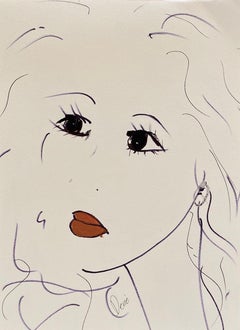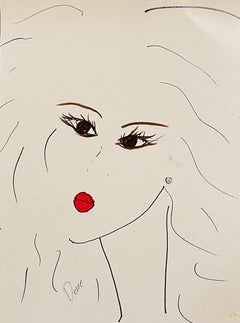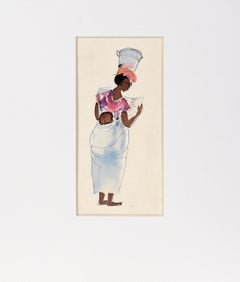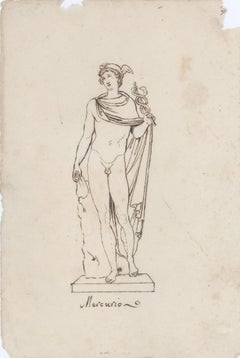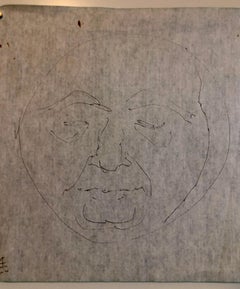Spider Portrait Drawings and Watercolors
to
1
2
Overall Width
to
Overall Height
to
2
2
2
133
3,429
1,957
1,943
1,649
1,233
717
659
623
495
440
359
142
101
88
83
76
67
58
54
2
2
2
2
2
2
2
2
2
Art Subject: Spider
"Looks away" by Devie
Located in Carmel, CA
Inspired by the theatre world, Devie had retained her own unique drawing strokes. Her works reflect an approachable other-worldliness. She paints a story to be told and answered.
Th...
Category
21st Century and Contemporary Modern Portrait Drawings and Watercolors
Materials
Ink, Acrylic, Handmade Paper
"Gentle soul" by Devie
Located in Carmel, CA
Inspired by the theatre world, Devie had retained her own unique drawing strokes. Her works reflect an approachable other-worldliness. She paints a story to be told and answered.
Th...
Category
21st Century and Contemporary Modern Portrait Drawings and Watercolors
Materials
Ink, Acrylic, Handmade Paper
Related Items
African Mama - Vintage Illustration in Ink and Watercolor
Located in Soquel, CA
African Mama - Vintage Illustration in Ink and Watercolor
A charming illustration, by Irene Pattinson (American, 1909-1999), shows a woman with a...
Category
1950s American Modern Figurative Drawings and Watercolors
Materials
Paper, India Ink, Watercolor, Pen
H 13 in W 10 in D 0.25 in
Mercurio / Mercury
Located in Middletown, NY
A lovely, early drawing of the Roman god Mercury.
Pen and brown ink on cream laid paper, with a partial crown and shield watermark, 7 1/4 x 4 7/8 inches (184x 123 mm) (matrix). In go...
Category
Mid-18th Century Old Masters Figurative Drawings and Watercolors
Materials
Ink, Handmade Paper, Laid Paper
Indian Dancer - Vintage Illustration in Ink and Watercolor
Located in Soquel, CA
Indian Dancer - Vintage Illustration in Ink and Watercolor
A stoic, dark-haired woman in elaborate dress is sitting cross-legged in this illustration by Irene Pattinson (American, 1909-1999). Pattinson uses fine ink line detail and a vibrant pink watercolor for a splash of color.
Signed at the bottom, "Irene Pattinson."
Provenance: The Artist, Estate of Irene Pattinson: David Carlson; Estate of Larry Miller Fine Art, Robert Azensky Fine Art.
Presented in a new white mat with foam core backing.
Mat size: 16"H x 12"W
Paper size: 11.75"H x 8.5"W
Image size: 7.5"H x 6.5"W
Irene Pattinson (American, 1909-1999) studied at the California School of Fine Art (now The San Francisco Art Institute), San Francisco State College and The Marion Hartwell School of Design. She was President of the San Francisco Woman Artists Association 1955-56.
Provenance: The Artist, Estate of Irene Pattinson: David Carlson; Estate of Larry Miller Fine Art, Robert Azensky Fine Art.
Solo Exhibitions: Lucien Labaudt Gallery 1955; San Francisco Museum of Art, 1961 (39 works).
Selected Group Exhibitions: San Francisco Art Association Annual 1948, 54, 55; San Francisco Woman Artists, 1957-1960; Oakland Art Museum Annual, 1951, 58; California Palace of the Legion of Honor, 1960; Richmond Art Center, 1955, 56, 57, 58; San Francisco Art Institute 1959, 60. The Art Bank of the San Francisco Art Association, 1958, 59, 60, 62, 63; Winter Invitational, California Palace of The Legion of Honor, San Francisco, 1960; Fourth Winter Invitational, California Palace of The Legion of Honor, San Francisco, 1963.
Awards: First Place, San Francisco Woman Artists Assoc., 1957, 1959; San Francisco Art Festival 1957;Literature: San Francisco Art Institute - A catalog of the Art Ban 1962/63; San Francisco and the Second Wave: The Blair Collection
Exhibitions:
1963 The Art Bank of the San Francisco Art Association, San Francisco, CA
1963 California Palace of The Legion of Honor: Forth Winter Invitational, San Francisco, CA
1962 The Art Bank of the San Francisco Art Association, San Francisco, CA
1961 San Francisco Museum of Art, San Francisco, CA
1960 California...
Category
1950s American Modern Figurative Drawings and Watercolors
Materials
Paper, India Ink, Watercolor, Pen
H 16 in W 12 in D 0.25 in
The Introduction, French School, 18th century
Located in Middletown, NY
In this charming scene a maid appears bashful as she is introduced by her mother to the shepherd’s son.
Ink and wash on hand made, cool-toned cream laid paper, 6 3/4 x 8 7/8 inches...
Category
Mid-18th Century French School Figurative Drawings and Watercolors
Materials
Ink, Watercolor, Handmade Paper, Laid Paper
Pierpaolo Piccioli for Moncler, Watercolor fashion illustration on paper.
Located in Miami Beach, FL
The artist has covered New York collections for over 16 years and has interviewed, as a journalist, several fashion designers and personalities for different publications. He loves t...
Category
21st Century and Contemporary Contemporary Portrait Drawings and Waterco...
Materials
Paper, Ink, Acrylic
H 15 in W 11 in D 0.1 in
Greg G - Stylized Baseball Card of Chicago Cub Greg Gross, Original, Framed
Located in Chicago, IL
Patrick Vale
Greg G
acrylic, ink, colored pencil on paper
24h x 19w in
60.96h x 48.26w cm
PKV015
See What I See
Why are Chicago and baseball so perfect f...
Category
2010s Modern Portrait Drawings and Watercolors
Materials
Ink, Acrylic, Archival Paper
The Assumption of Mary Magdalene, Italian School, 16th Century
Located in Middletown, NY
Brownish ink and grayish ink wash with white heightening on handmade cream laid paper, 10 5/8 x 8 1/4 inches (267 x 208 mm)(matrix). Scattered minor losses to top sheet edge (outside...
Category
16th Century Old Masters Figurative Drawings and Watercolors
Materials
Ink, Handmade Paper, Laid Paper
Chesterfield Sent to Coventry, or A Display of Military Education
Located in Middletown, NY
A wonderful 1824 preparatory drawing for a published work satirizing the famously ill-mannered 10th Hussars.
1842. Pen and ink with watercolor on watermarked J Whatman 1824 paper, 9...
Category
Mid-19th Century English School Figurative Drawings and Watercolors
Materials
Handmade Paper, Ink, Watercolor, Pen
Portrait of Raffaello / Italian School
Located in Middletown, NY
Graphite and ink on handmade, watermarked C & I Honig laid paper, 8 15/16 x 6 3/4 inches (226 x 170 mm). Signed illegibly in ink, lower margin. Scattered light creasing and surface...
Category
18th Century Italian School Portrait Drawings and Watercolors
Materials
Ink, Handmade Paper, Graphite
Illustration of Jewish Laborers by Chaim Goldberg
Located in New York, NY
Chaim Goldberg (Polish-American, 1917-2004)
Untitled, 20th century
Ink and gouache on paper
Sight: 11 1/4 x 14 in.
Framed: 19 1/2 x 22 1/4 x 7/8 in.
Signed lower left: Chaim Goldberg...
Category
20th Century Modern Figurative Drawings and Watercolors
Materials
Ink, Paper, Gouache
H 19.5 in W 22.25 in D 0.875 in
Dust Jacket (#1199)
By Jack Balas
Located in New York, NY
Watercolor, ink, and acrylic on paper
Signed in black ink, l.r.
Also signed and dated in blue ink, verso
This artwork is offered by ClampArt, located in New York City.
Price includes framing.
Jack...
Category
2010s Other Art Style Figurative Drawings and Watercolors
Materials
Paper, Ink, Acrylic, Watercolor
The Sermon on the Mount – French School, 19th century
Located in Middletown, NY
Pen and ink with wash on watermarked J Whatman 1814 paper, 11 x 8 1/4 (280 x 210 mm). Scattered minor edge losses at the left sheet edge, well outside of image area. Minor handling w...
Category
19th Century French School Figurative Drawings and Watercolors
Materials
Ink, Handmade Paper
Previously Available Items
Boston Abstract Expressionist Hyman Bloom Original Pencil Drawing Martin Sumers
By Hyman Bloom
Located in Surfside, FL
This is a unique artwork. This is an original Hyman Bloom drawing of fellow artist and his very good friend Martin Sumers.I believe this was drawn at the “variations of a theme” at Sumers gallery in NYC. The last two photos show a poster and a card from their shows. it is not included in this listing, it is just for provenance.
Provenance: Acquired from the Sumers estate collection.
Hyman Bloom (March 29, 1913 – August 26, 2009) was a Latvian-born American painter. His work was influenced by his Jewish heritage and Eastern religions as well as by artists including Altdorfer, Grünewald, Caravaggio, Rembrandt, Blake, Bresdin, James Ensor and Chaim Soutine. He first came to prominence when his work was included in the 1942 Museum of Modern Art exhibition "Americans 1942 -- 18 Artists from 9 States". MoMA purchased 2 paintings from the exhibition and Time magazine singled him out as a "striking discovery" in their exhibition review.
His work was selected for both the 1948 and 1950 Venice Biennale exhibitions and his 1954 retrospective traveled from Boston's Institute of Contemporary Art to the Albright Gallery and the de Young Museum before closing out at The Whitney Museum of American Art in 1955. In a 1954 interview with Yale art professor Bernard Chaet, Willem de Kooning indicated that he and Jackson Pollock both considered Bloom to be “America’s first abstract expressionist”, a label that Bloom would disavow. Starting in the mid 1950s his work began to shift more towards works on paper and he exclusively focused on drawing throughout the 1960s, returning to painting in 1971. He continued both drawing and painting until his death in 2009 at the age of 9
Hyman Bloom (né Melamed) was born into an orthodox Jewish family in the tiny Jewish village of Brunavišķi in what is now Latvia, then part of the Russian Empire
At a young age Bloom planned to become a rabbi, but his family could not find a suitable teacher. In the eighth grade he received a scholarship to a program for gifted high school students at the Museum of Fine Arts. He attended the Boston High School of Commerce, which was near the museum. He also took art classes at the West End Community Center, a settlement house. The classes were taught by Harold Zimmerman, a student at the School of the Museum of Fine Arts, who also taught the young Jack Levine at another settlement house in Roxbury. When Bloom was fifteen, he and Levine began studying with a well-known Harvard art professor, Denman Ross, who rented a studio for the purpose and paid the boys a weekly stipend to enable them to continue their studies rather than take jobs to support their families.
He took Bloom and Levine on a field trip to the Museum of Modern Art in New York, where Bloom was impressed by the work of Rouault and Soutine and began experimenting with their expressive painting styles.
In the 1930s Bloom worked sporadically for the Public Works of Art Project and the Federal Art Project (WPA), He shared a studio in the South End with Levine and another artist, Betty Chase. It was during this period that he developed a lifelong interest in Eastern philosophy and music, and in Theosophy.
He first received national attention in 1942 when thirteen of his paintings were included in the Museum of Modern Art (MoMA) exhibition Americans 1942: 18 Artists from 9 States, curated by Dorothy Miller. MoMA purchased two of his paintings from that exhibition, and he was featured in Time magazine. The titles of his paintings in the exhibition reflect some of his recurring themes. Two were titled The Synagogue, another, Jew with the Torah; Bloom was actually criticized by one reviewer for including "stereotypical" Jewish images. He also had two paintings titled The Christmas Tree, and another titled The Chandelier, both subjects he returned to repeatedly. Another, Skeleton (c. 1936), was followed by a series of cadaver paintings in the forties, and The Fish (c. 1936) was one of many paintings and drawings of fish he created over the course of his career.
Bloom was associated at first with the growing Abstract Expressionist movement. Willem de Kooning and Jackson Pollock, who first saw Bloom's work at the MoMA exhibition, considered Bloom "the first Abstract Expressionist artist in America." In 1950 he was chosen, along with the likes of de Kooning, Pollock, and Arshile Gorky, to represent the United States at the Venice Biennale. That same year Elaine de Kooning wrote about Bloom in ARTnews, noting that in paintings such as The Harpies, his work approached total abstraction: "the whole impact is carried in the boiling action of the pigment". In 1951 Thomas B. Hess reproduced Bloom's Archaeological Treasure in his first book, Abstract Painting: Background and American Phase, along with works by Picasso, Pollock, and others. Both de Kooning and Hess remarked on Bloom's expressive paint handling, a key characteristic of Abstract Expressionist painting.
As abstract expressionism dominated the American art world, Bloom became disenchanted with it, calling it "emotional catharsis, with no intellectual basis." In addition, instead of moving to New York to pursue his career, he opted to stay in Boston. As a result he fell out of favor with critics and never achieved the kind of fame that Pollock and others did. He disliked self-promotion and never placed much value on critical acclaim.
Many of Bloom's paintings feature rabbis, usually holding the Torah. According to Bloom, his intentions were more artistic than religious. He began questioning his Jewish faith early in life, and painted rabbis, he claimed, because that was what he knew. Over the course of his career he produced dozens of paintings of rabbis...
Category
20th Century Modern Figurative Drawings and Watercolors
Materials
Paper, Pencil
